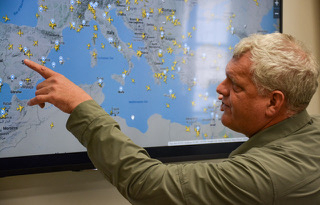The new iPhone 14 will let you send emergency messages via satellite when you're outside of cell phone service or coverage areas.
What will that mean for travelers who have relied on satellite messaging devices?
The Apple iPhone SOS feature will not replace your Satellite Messaging and Tracking device, at least not right away. There are several limitations everyone should be aware of before swapping their current satellite communications device for the latest smartphone from Apple.
The Apple iPhone 14 will indeed have a limited satellite connectivity feature so you can contact 911 services outside of cell phone service areas. This can be a lifesaving feature under specific circumstances. But it is not a replacement for your InReach, Zoleo, Bivy, Spot, or other satellite messaging and tracking devices. The new Apple satellite feature is nowhere close to replacing a satellite phone, yet the Apple product will ONLY contact 911 emergency services.
According to the company, “when you make a call with SOS, your iPhone automatically calls the local emergency number (911).”
The smartphone company configured the iPhone 14 antennas to connect to satellites. Users have to employ a system that shows them where to point their phone toward the sky, according to a CNET review.
Apple’s emergency SOS service will be available to users in the US, Canada, Puerto Rico and the US Virgin Islands, but it will not be available at launch in Guam or American Samoa. “Foreign travelers will be able to use the Emergency SOS service when visiting the US and Canada, unless they bought their iPhone 14 in China, Hong Kong or Macao,” according to CNET.
More specifically, the Apple iPhone SOS feature will not work worldwide like the inReach device. The iPhone SOS feature uses the GlobalStar constellation of satellites reaching more than 120 countries – but not worldwide. Most satellite messaging and tracking devices use the Iridium constellation of satellites, a global network of low earth orbiting satellites providing access to voice and data services anywhere on Earth, making it easier for the user to connect with the satellite.
Backcountry enthusiasts should not replace their satellite messaging devices. A satellite messaging device allows you to send SMS messages and e-mails to anyone - not just the local municipal 911 emergency response service. Satellite messaging devices usually have a tracking feature, where the user can send a message to specific recipients, and the recipient can follow the movement and location of the sender with a map graphic including the location, geographic coordinates, direction of travel, and the traveling speed of the sender.
Apple states in their satellite feature description that satellite connectivity usually requires expensive and bulky equipment to support the connectivity requirements of satellite communication. Anyone who owns a satellite messaging and tracking device understands that these are comparable in size with the iPhone and are significantly less expensive than an iPhone, usually in the $300-$500 range.
Having both cellular and satellite connectivity on a single device is a huge technological breakthrough. Users will be safer as they will always be able to contact emergency services. As the satellite functionality of smartphones expands, there could be a time when they eclipse the capabilities and features of satellite messaging and tracking devices and satellite phones.
But until then, devices with satellite messaging and tracking capabilities should be the standard communication device for those who venture beyond the range of cell phone connectivity. Your satellite messaging device does much more than send an SOS distress message.
— Harding Bush

Harding Bush is a former Navy SEAL and manager of security operations for Global Rescue, the world's leading provider of medical, security, evacuation and travel risk management services. Bush is an expert in procedures for high-risk travel, cultural awareness, crisis preparedness, leadership and operational planning.